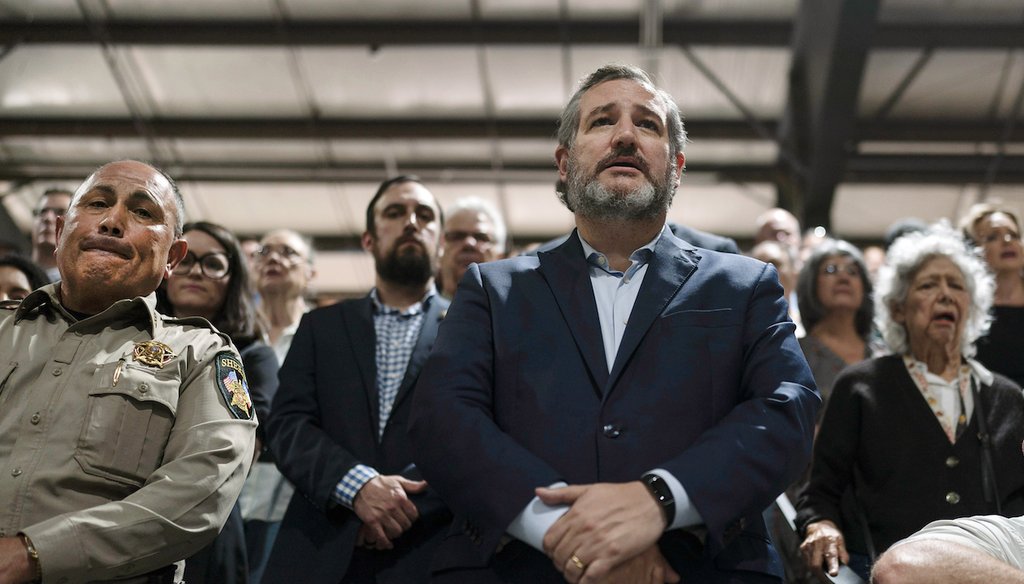Stand up for the facts!
Our only agenda is to publish the truth so you can be an informed participant in democracy.
We need your help.
I would like to contribute

Sen. Ted Cruz, R-Texas, attends a prayer vigil with Uvalde County Sheriff Ruben Nolasco, left, in Uvalde, Texas, on May 25, 2022. (AP)
Ted Cruz spins partisan blame for failure of gun legislation
If Your Time is short
• In the wrangling over gun-related bills in 2013, then-Senate Majority Leader Harry Reid, D-Nev., set a 60-vote threshold for all amendments as a response to the Republicans’ own threats to filibuster what Democrats wanted to pass.
• Republicans unanimously agreed to the 60-vote threshold for all amendments offered by Reid.
• The Cruz-Grassley amendment attracted majority support, but not 60 votes. Democratic amendments with majority support were, in turn, filibustered by Republicans.
Sen. Ted Cruz, R-Texas, has long opposed restrictive gun legislation. After the May 24 school shooting in Uvalde, Texas, Cruz appeared on Fox News to discuss what had happened and what should be done on gun policy.
Among other things, Cruz blamed Democrats for blocking what he said were reasonable gun regulations in 2013, not long after the Sandy Hook Elementary School shooting in Newtown, Connecticut.
In the interview, Cruz cited an amendment he sponsored along with Sen. Chuck Grassley, R-Iowa:
"In 2013, I introduced legislation called Grassley-Cruz which targeted felons and fugitives and those with serious mental illness. It directed the Department of Justice to do an audit of federal convictions to make sure felons are in the database. It directed the Department of Justice to prosecute and put in jail felons and fugitives who try to illegally buy firearms.
"In the Harry Reid Democrat(ic) Senate, a majority of the Senate voted in favor of Grassley-Cruz, but the Democrats filibustered it. They demanded 60 votes. They defeated it, because they wanted to go after law-abiding citizens instead of stopping the bad guys."
Was that accurate?
A review of the legislative wrangling from 2013 shows that Cruz accurately explained the voting on the Grassley-Cruz amendment. However, Cruz is wrong to suggest that only Democrats were to blame for the amendment’s failure. Cruz’s statement leaves out his own party’s use of the very same tool — the 60-vote requirement to break a filibuster — to block other measures that were able to secure majority support in the chamber.
In seeking to enact legislation after Sandy Hook, the then-majority leader, Sen. Harry Reid, D-Nev., established a 60-vote threshold on all amendments to his Safe Communities, Safe Schools Act of 2013.
Reid’s technique — allowing a fixed number of amendments for both sides, each requiring a 60-vote majority for passage — has become common in the Senate in recent years, said Steven S. Smith, a political scientist at Washington University in St. Louis and author of "The Senate Syndrome: The Evolution of Procedural Warfare in the Modern U.S. Senate."
It usually happens like this: The minority party makes clear they’re going to filibuster an underlying bill, as Republicans did with the gun legislation backed by the Democratic leadership in 2013. To counter this filibuster threat, the majority leader uses a procedural maneuver to block the minority from offering any amendments.
This inevitably produces a stalemate. The usual way of resolving this stalemate is for each side to agree to vote on a limited number of amendments, each with a stiff 60-vote threshold.
"Sounds crazy, right?" Smith said. "It is, but it gives senators on both sides an opportunity to offer alternatives and put senators on the record."
The parameters for debate and voting are set in motion by the majority leader’s "unanimous consent" request. If any senator objects to the majority leader’s request, the voting plan doesn’t go forward. But as long as no one objects, the votes on amendments can proceed, with the supermajority threshold.
An important point Cruz leaves out is that every Republican accepted Reid’s ground rules.
The Senate’s makeup at the time was 55 Democrats and 45 Republicans.
Ultimately, when the voting was held on April 17, 2013, nine amendments received a vote. A few that were relatively uncontroversial passed with a 60-vote supermajority, while a few fell short of even a simple 50-vote majority.
The Cruz-Grassley amendment attracted majority support, but not 60 votes. It received a vote of 52-48, with nine Democrats voting for it (Max Baucus and Jon Tester of Montana, Mark Begich of Alaska, Joe Donnelly of Indiana, Kay Hagan of North Carolina, Heidi Heitkamp of North Dakota, Mary Landrieu of Louisiana, Claire McCaskill of Missouri, Mark Pryor or Arkansas) and two Republicans voting against (Mark Kirk of Illinois and Mike Lee of Utah).
The same day, the Senate voted on an amendment sponsored by Sens. Joe Manchin, D-W.Va., and Pat Toomey, R-Pa., that would have toughened background checks for purchasing guns.
The Manchin-Toomey amendment, which was backed by the Democratic leadership, also received a majority vote (54-46) but it, too, fell short of the 60 votes required for passage. It attracted two more votes than Grassley-Cruz did.
Four Republicans joined most Democrats in supporting Manchin-Toomey — Susan Collins of Maine, Kirk, John McCain of Arizona, and Toomey. Five Democrats joined Republicans in opposition: Baucus, Begich, Heitkamp, Pryor, and Reid. (Reid’s vote against it was not due to the substance of the measure but rather as a procedural tactic that would allow him to call the amendment up at a later date.)
Meanwhile, two other amendments secured majority support but fell short of 60 votes. One focused on firearm trafficking and was sponsored by Sen. Patrick Leahy, D-Vt. It resulted in a 58-42 vote. Another amendment that addressed veterans’ gun rights was sponsored by Sen. Richard Burr, R-N.C. It produced a 56-44 vote.
Steve Guest, a special advisor for communications with Cruz, said the senator’s statement was "absolutely correct."
Guest said it is "disingenuous to say that somehow the blame is on both sides of the aisle for filibustering Grassley-Cruz. The fact of the matter is Grassley-Cruz would have passed had over 80% of the Democrats in the Senate not blocked it via the filibuster."
This recording of history is incomplete, however. Reid set the 60-vote threshold in response to Republican threats to filibuster the Democratic measure, meaning that both sides were playing the same game. And to get out of the standoff, Republicans unanimously agreed to the 60-vote threshold Reid established for all amendments.
This endgame has been common since the 1990s, Smith said, creating a system where senators on either side can avoid accountability by taking votes that have no chance of passage but serve the party’s campaign messaging.
"Senators can make all kinds of claims that are half-truths, and the public cannot possibly make sense of it," Smith said.
Our ruling
Cruz said that in 2013, under a Democratic Senate, "a majority of the Senate voted in favor of" the Grassley-Cruz amendment to tighten background checks, "but the Democrats filibustered it."
This retelling is accurate up to a point, but it leaves out half the story.
Reid set a 60-vote threshold for all amendments because the Republicans’ made their own filibuster threats against what the Democrats wanted to pass. To get out of the standoff, Republicans unanimously agreed to the 60-vote threshold for all amendments.
The Cruz-Grassley amendment attracted majority support, but not 60 votes. The same was true of the Democratic-backed Manchin-Toomey amendment.
We rate the statement Half True.
PolitiFact Texas reporter Nusaiba Mizan contributed to this report.
Our Sources
Ted Cruz, interview with Fox News, May 26, 2022
Congress.gov, Cruz-Grassley amendment, 2013
Cruz-Grassley roll call vote
Congress.gov, Manchin-Toomey amendment, 2013
Manchin-Toomey roll call vote
Congress.gov, Leahy amendment, 2013
Leahy amendment roll call vote
Congress.gov, Burr amendment, 2013
Burr amendment roll call vote
ABC News, "What we know about the victims of the Texas school shooting in Uvalde so far," May 27, 2022
NPR, "Ted Cruz walks away from a reporter who asked why the U.S. has so many mass shootings," May 27, 2022
Washington Post Fact Checker, "Ted Cruz’s misleading memories of his 2013 gun proposal," March 25, 2021
PolitiFact, "Could Ted Cruz measure have prevented the Texas church shooting? Not likely," Nov. 10, 2017
Email interview with Steven S. Smith, political scientist at Washington University in St. Louis, May 26, 2022
Email interview with Steve Guest, special advisor for communications with Ted Cruz, May 26, 2022
Browse the Truth-O-Meter
More by Louis Jacobson
Ted Cruz spins partisan blame for failure of gun legislation
Support independent fact-checking.
Become a member!
In a world of wild talk and fake news, help us stand up for the facts.








































